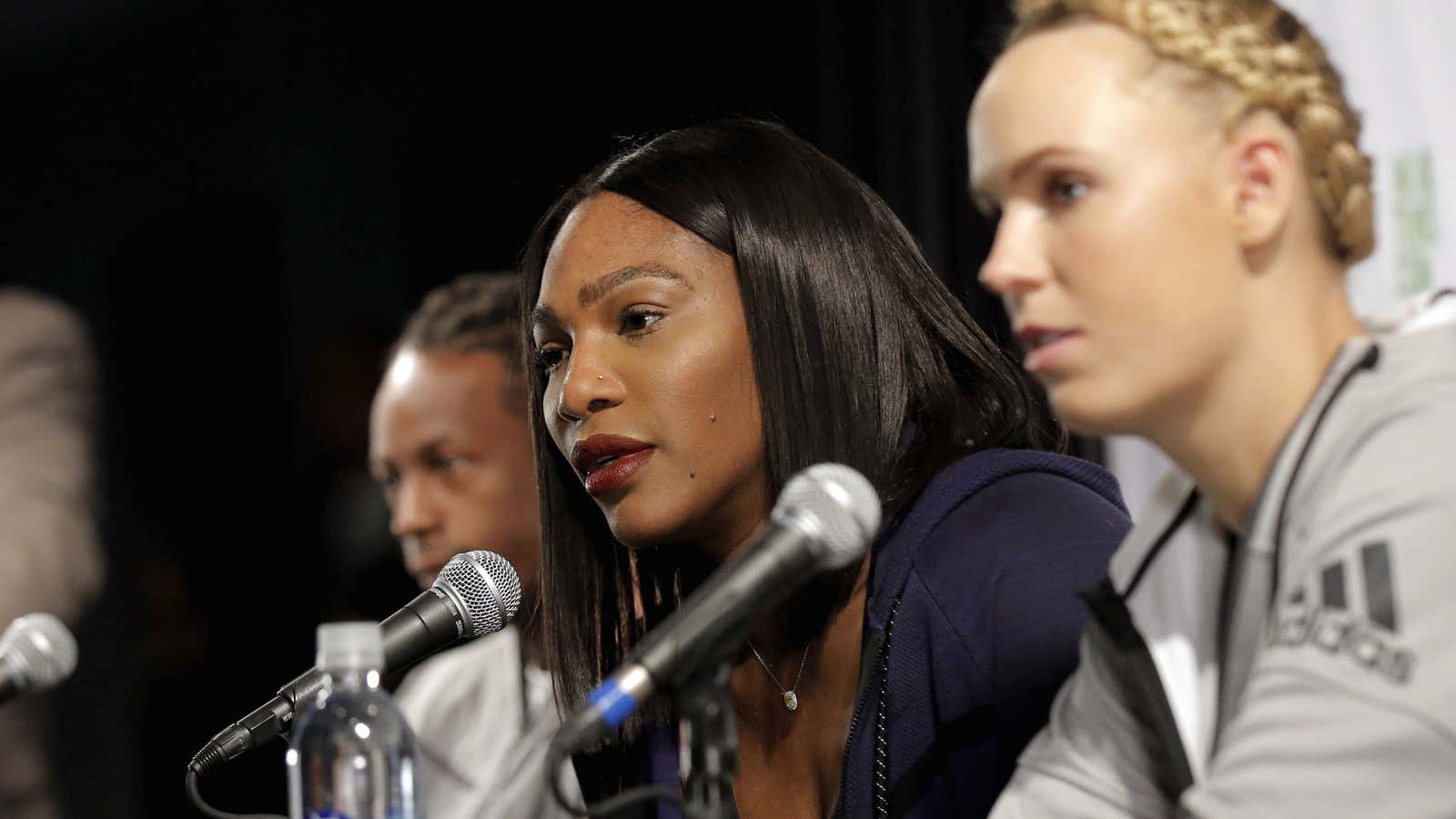Men stay in power by creating the illusion of women’s inferiority. For fresh evidence of the gender myths and stereotypes that reinforce sexism in American culture, look no further than Raymond Moore, the now-former CEO of Indian Wells Tennis Garden. Moore’s misogynistic beliefs about professional tennis “lady players” took center court at an otherwise uneventful Sunday morning press conference in advance of the BNP Paribas Open finals in California.
“If I was a lady player, I’d go down every night on my knees and thank God that Roger Federer and Rafa Nadal were born,” Moore told reporters. “Because they have carried this sport. They really have.” This astounding display of sexism debases female tennis players via sexual innuendo while simultaneously arguing that their success, and the entire success of the Women’s Tennis Association (WTA), is somehow due to men—the “real” athletes.
Yet Federer and Nadal have not carried women’s tennis. Women have carried women’s tennis. Serena Williams, born in 1981, won her first professional tennis tournament (the US Open) in 1999. In contrast, Federer, also born in 1981, didn’t win his first professional tennis tournament until 2003 (Wimbledon). And Rafael Nadal didn’t win his first professional tennis tournament until 2005 (the French Open).
So, you tell me: who’s carrying who? In the context of chronology, the men have been riding Serena’s coattails.
Williams herself gently alluded to this fact in a statement responding to Moore:
“I don’t think any woman should be down on their knees thanking anybody like that,” she said after losing to Victoria Azarenka in the Mar. 20 final. “I think Venus, myself, a number of players—if I could tell you every day how many people say they don’t watch tennis unless they’re watching myself or my sister—I couldn’t even bring up that number. So I don’t think that is a very accurate statement.”
Statistics are behind Serena. “For the last two US Opens, the women’s final scored higher TV ratings than the men’s final,” CNBC’s Stephanie Kratter noted, citing research by SMG Insight which also concluded that the “global TV and digital audience for women’s tennis rose 22.5% [in 2014] compared to 2013.” Indeed, in 2013, the women’s US Open final (again between Serena Williams and Victoria Azarenka) drew nearly twice the audience in ratings (4.9 to 2.8) of the men’s final, which featured Nadal and Novak Djokovic. And while the 2015 men’s final had more viewers than the women’s final, let’s not forget–as Ben Rothenberg at The New York Times reminds us–that last year’s “excitement over [Williams’s] Grand Slam bid caused tickets to the women’s final to sell out before the men’s final for the first time in tournament history.”
Moore apologized for his remarks in a statement. “At my morning breakfast with the media, I made comments about the WTA that were in extremely poor taste and erroneous. I am truly sorry for those remarks, and apologize to all the players and WTA as a whole.” Moore’s hasty apology ultimately proved insufficient; he has since resigned. But it was also utterly devoid of any understanding of the “erroneous” nature of his comments; neither does his apology seem genuine, since he does not explain the logic behind his reasoning.
The casual reinforcement of stereotypes about women and female athletes isn’t simply an issue of political correctness or bad word choice. His comments quite clearly imply that women cannot be athletes in their own right–only lesser, “lady,” versions, allowed to play on the global stage for men’s pleasure. Hence the “very attractive prospects” to whom Moore alluded in his original comments. Sexism in culture, and sports in particular, occurs when we refuse to see women as athletes and instead reduce them to objects of attraction. Recall last year’s request that a female tennis player give a tennis commentator “a twirl” in her post-match interview.
What is especially insidious about Moore’s remarks is their subtle racism—that these “attractive” women “can assume the mantle of leadership once Serena decides to stop.” The implication is magnified by Williams’s complicated history at Indian Wells. She and her family were at the receiving end of racist taunts and racist aggression after she had to drop out of the tournament in 2001 because of an injury.
The belief that “lady” tennis is in essence a lesser version of the main, male event is further underscored by the blowback that women players are receiving for gender parity. Unlike practically every other professional sport, there is no pay gap at the grand slam level in tennis, with pay parity being attained in 2007. Wimbledon was the last grand slam to give women players equal pay. After his victory this weekend at Indian Wells, Novak Djokovic said that men should earn more than women “because the stats are showing that we have much more spectators on the men’s tennis matches.” He then paid some pretty poor lip service to his female peers by referring to lady “hormones” as a “challenge” that complicates said players’ lives. How progressive.
The tennis world’s long history of sexism serves to remind us that hard-won advancements like equal pay don’t always translate to social equality. What needs examination, now, are the still-lurking attitudes of the tennis elite who continue to define the image of men and women on the court in sexist terms. These attitudes are insulting to champions of any gender.
